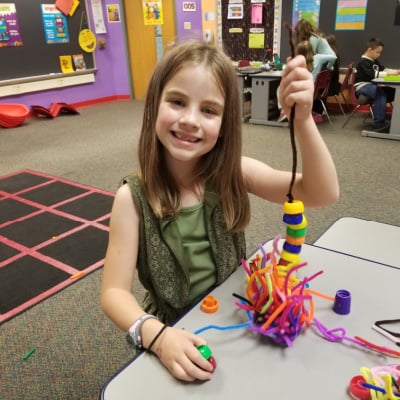Use of Space and Time
![]()
Student-centric learning requires changes in the way instructional time is used and the environments in which learning occurs. Opportunities to better utilize in-school and out-of-school time and space to align with individual learner needs, pace, interests, and preferences intersect with pedagogical and instructional approaches (e.g., competency-based learning, blended learning) to make learning more personalized and learning opportunities more accessible. This transition is possible through innovative uses of technology for facilitating instruction; assessing student learning; engaging students in experiences; disseminating information and resources; providing timely and coherent student feedback; partnering with families and stakeholders; providing the necessary infrastructure to foster collaboration; and encouraging flexible, anytime, anywhere learning opportunities. In future ready schools, every spaces is seen as a possible learning space, and these areas are designed with intention and learning science research in mind.
Flexible Learning, Anytime, Anywhere
By leveraging technology, curricula, and media resources, learning options are available for students at any time of day, from home, at school, and in the community. The value of anytime, anywhere learning depends on access and capacity—ubiquitous, robust internet access and the capacity to use digital learning tools and resources creatively and effectively.
New Pedagogy, Schedules, and Learning Environments for Personalized Learning
To facilitate learner-centered personalized learning, educators collaboratively identify and validate innovative scheduling configurations and explore and examine various designs that allow for the flexible use of time and space. Associated resources are diverse in level, language, interest, and media and available to all students both synchronously and asynchronously to promote flexibility and diverse needs of the growing mosaic of learners.
Competency-Based Learning
A facet of personalized learning known as competency-based learning (CBL) integrates student voice and choice with flexibly-paced learning, timely and adequate support, and varied demonstration methods of academic proficiency. The learning pace is flexible; based on the needs of individual students; and focused on complex, often project-based, learning tasks that foster interest, agency, and authenticity. Students receive timely support to accommodate learning needs and guarantee access to appropriate content and resources. Learners must demonstrate competency through explicit, measurable, and transferable outcomes that require the application and creation of knowledge before they move on to a new, targeted standard or course.
Strategies for Providing Extended Time for Projects and Collaboration
Districts are reimagining the school day and school year by redesigning and extending learning time, providing greater access to integrated enrichment and quality instruction, and adjusting teacher course loads to offer “office hours” that allow for targeted direct support and collaboration. When possible, campus schedules and class time allocations should be flexible, allowing for extended periods and work time for complex projects. Technology and innovative instructional strategies enable students to use time productively during and beyond the school day, often redefining the role, scope, function, and schedule of homework. Access to the school library, databases, and network outside school hours are critical to support student-led exploration and provide equitable access to resources.
Intentional and Inclusive Learning Space Design
Designing learning spaces is about how design impacts the brain and learning, not about being pretty for Pinterest. Future ready educators understand that every child needs and deserves to know that they belong, both as a part of the class community and in the learning space itself. As such, schools are leveraging a research-based approach, that takes into consideration: (1) naturalness: considered the effects of lighting, temperature, and air quality, (2) individualization: considered the ownership and flexibility of the space, and (3) stimulation (appropriate level of): considered the complexity and color of the space. These inclusive spaces are culturally responsive and gender neutral.
Flexible Spaces for Responsive Instructional Pedagogy
Future ready educators understand that the learning experience should drive the design of the space, not vice versa. Flexible spaces amplify a place for learners to explore, design, and create, as opposed to teacher-centric environments designed for consumption and regurgitation. Future ready spaces are designed to empower agency and active learning, not demand compliance or passive experiences. Flexible spaces often include various “zones”, are mobile and fluid, allow for aspects of personalization, contain easily moveable furniture, and have seamless connectivity.
Learning Beyond the Classroom
Future ready schools recognize the value of learning that occurs, both formally and informally, outside of the school walls. Whether through virtual courses, remote learning at home, or through live event opportunities such as field trips, learning that occurs in non-traditional spaces are recognized as a valued part of a learner’s overall experience. Future ready schools prioritize equity in both opportunity and access to ensure dynamic experiences for every child, particularly those from traditionally marginalized groups.
Featured Resource
[Blog]Creativity Unlocked: 1:1 Initiative and New Makerspaces Make Learning Personal in Deer Lakes School District
School leaders have redesigned the old computer labs and other unused or underutilized spaces into makerspaces to promote project-based learning experiences for students.
Implementation Guide
Creative Scheduling Approaches
To reduce the achievement gap, schools can implement innovative schedules aimed at improving student learning; the use of time is a valuable but often untapped resource.
